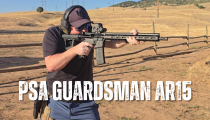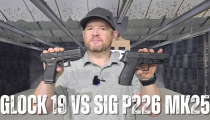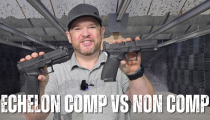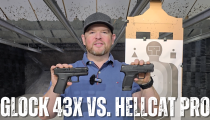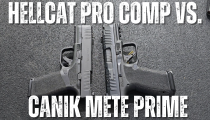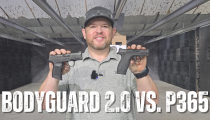Sig Sauer MCX Rattler 300BLK Review
Get the Sig MCX Rattler LT 300BLK here: https://alnk.to/c08sTpE
The SIG Sauer MCX Rattler is a compact, modular firearm introduced in 2015 as part of the broader MCX platform, which itself evolved from SIG’s earlier MPX pistol-caliber subgun. Designed initially to meet a U.S. Special Operations Command (SOCOM) requirement, the Rattler aimed to replace aging 9mm submachine guns like the MP5 with a more potent rifle-caliber option. The 300 Blackout cartridge—developed by Advanced Armament Corporation in the early 2000s and approved by SAAMI in 2011—was chosen for its versatility, offering effective ballistics in short barrels and compatibility with subsonic rounds for suppressed use, a key SOCOM need.
SIG Sauer, a company with roots tracing back to Switzerland’s Schweizerische Industrie Gesellschaft (SIG) in 1853 and its merger with J.P. Sauer & Sohn in the 1970s, brought its expertise to the Rattler. Based in New Hampshire for its U.S. operations, SIG tailored the MCX Rattler for rapid deployment and close-quarters scenarios, shrinking the standard MCX’s 9-inch barrel to a stubby 5.5 inches. Initially offered as a short-barreled rifle (SBR) with a folding stock or a pistol with a brace, the Rattler has since expanded into variants like the Canebrake and LT models, reflecting SIG’s ongoing refinement of the platform for military, law enforcement, and civilian use.
Specifications
The SIG Sauer MCX Rattler in 300 BLK is a semi-automatic, gas-piston-operated firearm built for compactness and adaptability. Here’s a breakdown of its core specs in its standard pistol configuration (PMCX-300B-5B):
-
Barrel Length: 5.5 inches, cold hammer-forged with a 1:5 twist rate optimized for 300 BLK’s heavier projectiles (110-220 grains).
-
Overall Length: Approximately 23 inches with the Pivoting Contour Brace (PCB) extended; 16.5 inches folded.
-
Height: Around 8 inches.
-
Width: 2.8 inches at its widest point.
-
Weight: 5.1 pounds unloaded, without optics or accessories.
-
Magazine Capacity: Ships with one 30-round magazine (often a Lancer L5 AWM or Magpul PMAG).
-
Trigger: SIG’s Enhanced flat-blade trigger, averaging 5.5-6 pounds pull weight, though earlier models had heavier, less refined triggers (upgraded in later production).
-
Operating System: Short-stroke gas piston with an adjustable two-position gas valve (standard and suppressed settings).
-
Sights: Optics-ready Picatinny top rail; no iron sights included, though suppressor-height sights can be added.
-
Handguard: Free-floating M-LOK, 4.5 inches long, allowing accessory attachment despite the short barrel.
-
Finish: Black hard-coat anodized aluminum frame and handguard.
-
Additional Features: Ambidextrous AR-style controls, SIG QD suppressor-ready flash hider, and a compact charging handle (upgradable to larger options like Geissele’s Super X).
The 300 BLK chambering shines in this short barrel, delivering full powder burn for both supersonic (e.g., 125-grain) and subsonic (e.g., 220-grain) loads, unlike 5.56 NATO, which loses efficiency below 10 inches. The gas piston system eliminates the AR-15’s buffer tube, enabling the folding brace or stock design that defines the Rattler’s portability.
Design and Performance Context
The Rattler’s defining trait is its size—or lack thereof. At 16.5 inches folded, it’s among the smallest rifle-caliber firearms available, making it a standout personal defense weapon (PDW). The 5.5-inch barrel and gas piston system keep it reliable, with users reporting thousands of rounds without malfunctions when properly tuned (e.g., adjusting the gas valve for suppressed vs. unsuppressed shooting). Accuracy is solid for its class—expect 1.5-3 MOA at 100 yards with quality ammo like Barnes 110-grain TAC-TX or Hornady 208-grain A-MAX, though precision drops off past 200 yards due to 300 BLK’s ballistic limits.
Recoil is manageable, especially with subsonic rounds and a suppressor, where it’s described as soft and straight-back, akin to a firm push rather than a snap. Unsuppressed supersonic loads are louder—think 160-165 dB at the muzzle—producing a noticeable fireball from the short barrel, but the M-LOK handguard and brace provide good control. The Rattler excels in tight spaces, a trait SOCOM valued for vehicle ops or room clearing, and civilians echo this for home defense or truck gun roles.
However, it’s not without quirks. The stock trigger in early models drew criticism for being mushy (8+ pounds), though newer units have improved. The compact charging handle can abrade knuckles during rapid manipulation, and the handguard’s tight fit limits suppressor compatibility—SIG’s own cans work best, while some 1.5-inch diameter models (e.g., SilencerCo Omega) won’t thread fully. At $2,729 MSRP (often $2,300-$2,500 retail), it’s a premium buy, competing with custom AR builds or alternatives like the Q Honey Badger.
Historical Evolution and Relevance
The Rattler emerged as 300 BLK gained traction in the 2010s, a cartridge born from SOCOM’s need for a round that paired AR-15 familiarity with subsonic suppression and short-barrel performance. The MCX platform, launched in 2015, scaled up the MPX’s piston-driven modularity to rifle calibers, with the Rattler shrinking it further by 2017. Later iterations like the Rattler LT (6.75-inch barrel, enhanced ambidextrous controls) and Canebrake (SD handguard for suppressors) show SIG adapting to user feedback and market trends.
Its military roots are evident—tested by special forces for discreet carry and rapid deployment—but its civilian appeal lies in its crossover potential. The pistol version sidesteps NFA restrictions (no tax stamp needed), broadening its reach. The 300 BLK’s versatility—quiet subsonics for stealth, punchy supersonics for range—makes it a jack-of-all-trades, though mastering it requires ammo awareness



